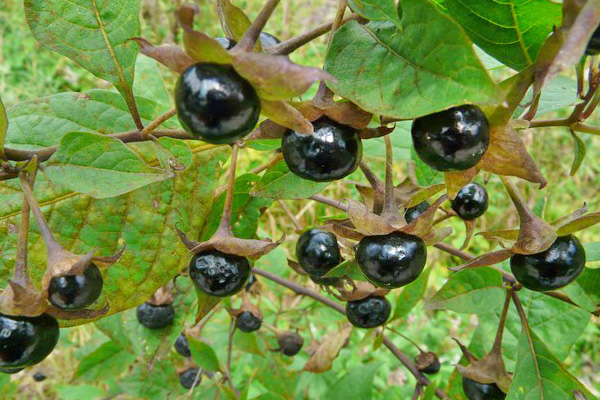Belladonna is not an herb that you are going to want to stock your pantry with. While it has its benefits, this is an herb that can be very dangerous and sometimes even fatal. It has some medicinal properties to it and has an interesting history but it can be very dangerous. The nickname “deadly nightshade” is a good clue of its potency. There is however a tincture that comes from this plant that is used for medicinal purposes. Belladonna is a perennial herb that is native to Europe and Asia Minor but is now grown quite often in the United States, Europe, and India. When the plant is in full bloom the plant is harvested and then dried for use.
The most important contribution from Belladonna is atropine which is an important agent that is useful in dilating the pupils of the eye. This has proven to be very beneficial. Even small doses of atropine can cause the heart rate to increase. Some cough syrups are known to contain atropine and are used for bronchitis and whooping cough. Further it is used to soothe the stomach lining prior to an anesthetic being administered and also for peptic ulcers.
Belladonna goes by many different names but has been used for over 500 years. While growing in the wild, which belladonna commonly does, a slight dose can be fatal. In the earliest times when Belladonna was first used it was cosmetic purposes. Women felt that if they used it to dilate their pupils that they would look more sexy and alluring. That is why the name Belladonna means “beautiful lady” in Italian. Yet, it is still used in many eye doctors’ offices across the country to this day.
Belladonna also has other great benefits for purposes of what it is used for today as it has the ability to dry up bodily fluids such as breast milk, saliva, perspiration, and mucous. The alkaloids in Belladonna are used for many conditions such as gastrointestinal disorders such as colitis, diverticulitis, irritable bowel syndrome, colic, diarrhea, and peptic ulcer. It also works for asthma, excessive sweating, excessive nighttime urination and incontinence, headaches and migraines, muscle pains and spasms, motion sickness, Parkinson’s disease, and biliary colic.
Quite often Belladonna is used as homeopathic remedies such as the common cold, earaches, fever, menstrual cramps, sunstroke, toothaches, headaches, sore throats, and boils. How the patient ingests and how much they ingest is determined by a few various factors such as their symptoms, mood, and overall temperament. When Belladonna is administered for homeopathic use it is highly diluted because of the toxicity level of it.
No one should ever use Belladonna as a self help measure and it should only be taken under the care of a qualified doctor. The doses given of Belladonna are always in very low doses. When Belladonna is prescribed it is either added to sugar pellets or mixed with other types of drugs and is available by prescription only. So while it is clear that Belladonna is an extremely dangerous herb it is also very beneficial when used correctly.





















Leave a Reply
Your email address will not be published. Required fields are marked (required)